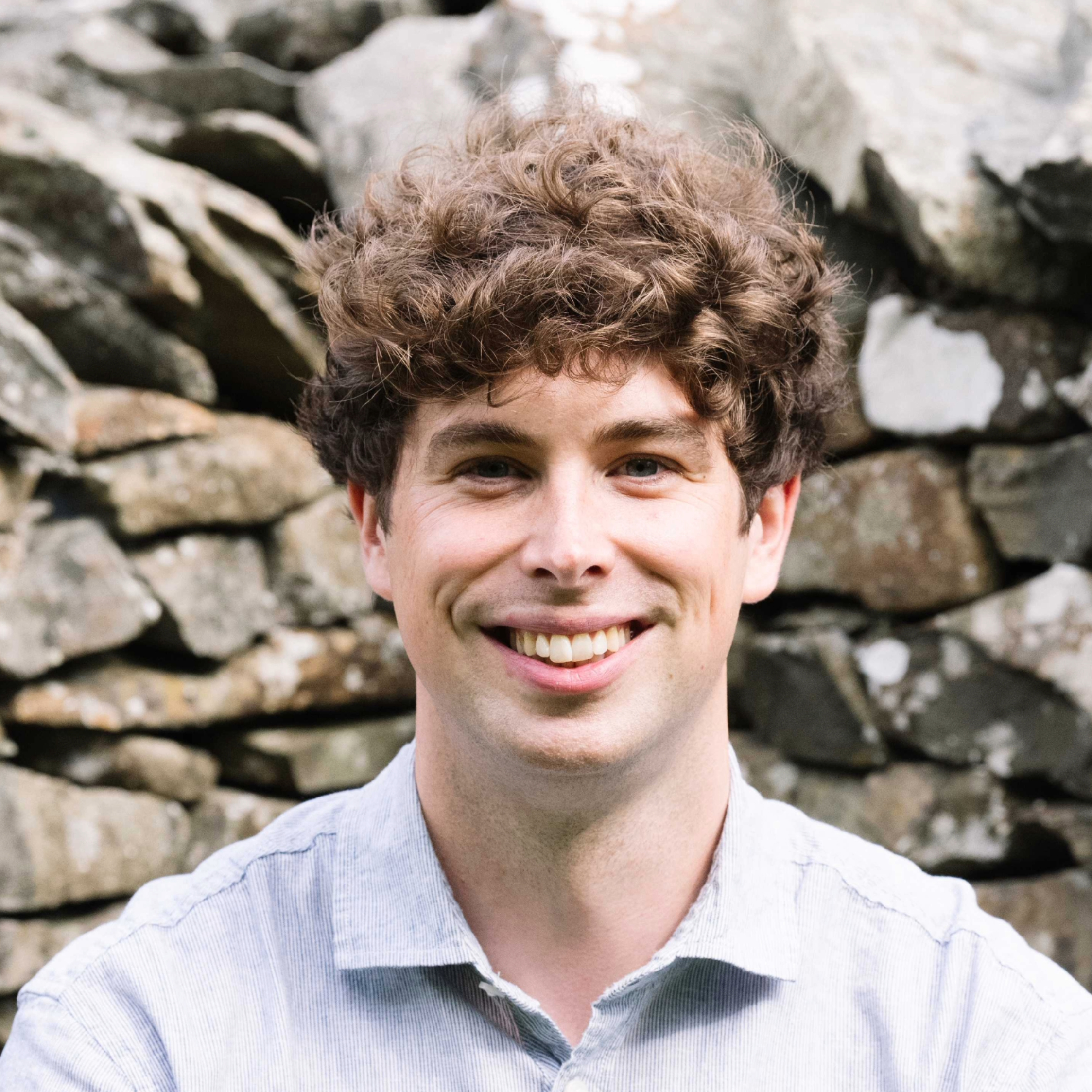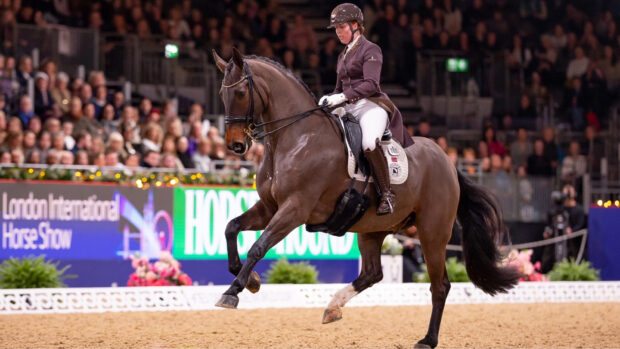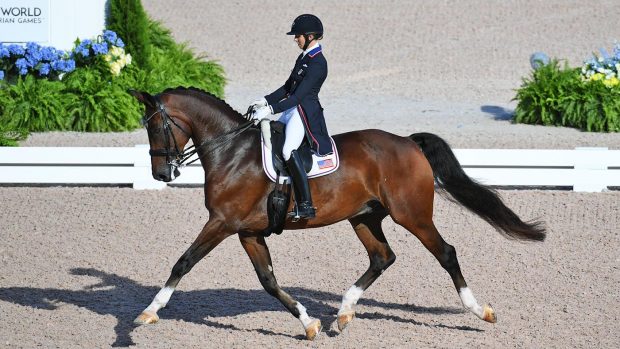In this exclusive, subscriber-only interview, Becky Moody shares what she looks for in a young horse and we delve into her training routine and the ethos that helped get her home-bred Jagerbomb to the Paris Olympics
One of the most remarkable aspects of Becky Moody and Jagerbomb’s success at the Paris Olympics was that Becky not only rode but also bred and trained Jagerbomb herself, guiding him through every stage of his development.
In a sport often clouded by the misconception that wealth and privilege are required to reach the top, their journey highlighted what’s possible through dedication and skill, making their achievements all the more inspiring.
Becky’s had to be patient throughout a career that’s had its fair share of ups and downs, and that patience carries over to her approach to training.
{"content":"PHA+4oCcVGhlIG1vc3QgaW1wb3J0YW50IHRoaW5nIGlzIHRoYXQgdGhlIGhvcnNlcyBnbyBhdCB0aGUgcmF0ZSB0aGF0IHRoZXkgbmVlZCB0byBnbyBhdCwgYW5kIHRoYXQgeW91IGhhdmUgdGhlaXIgYm9kaWVzIGFuZCBtaW5kcyBpbiB0aGUgcmlnaHQgcGxhY2UgdG8gZG8gaXQs4oCdIEJlY2t5IGV4cGxhaW5zLiDigJxJIGRvbuKAmXQgaGF2ZSBhbnkgaGFyZCBhbmQgZmFzdCBydWxlcyB3aGVuIGl0IGNvbWVzIHRvIHRyYWluaW5nIHRoZW0gdGhyb3VnaCB0aGUgbGV2ZWxzLjwvcD4KPHA+4oCcQWx0aG91Z2ggSSBkaWQgc2F5IGZvciBtYW55IHllYXJzIHRoYXQgSeKAmWQgbmV2ZXIgYnV5IHNvbWV0aGluZyB0aGF0IHdhcyBiYWNrZWQgd2l0aG91dCBzaXR0aW5nIG9uIGl0LCBidXQgSSBicm9rZSB0aGF0IHJ1bGUgb3ZlciBDb3ZpZCB3aGVuIFJlYmVjY2EgRHVkbGV5LCBhbiBhZ2VudCBJIHdvcmsgd2l0aCBhIGxvdCwgcmFuZyBtZSBhYm91dCBhIHZlcnkgbmljZSB0aHJlZS15ZWFyLW9sZCB0aGF0IHNoZSB0aG91Z2h0IHdhcyBteSBraW5kIG9mIGhvcnNlLiBUaGF0IHdhcyBNYWdpYyBEcmVhbSDigJMgc2hlIHdhcyB0aGUgZmlyc3Qgb25lIHdlIHRvb2sgYSBwdW50IG9uIGFuZCBib3VnaHQgd2l0aG91dCByaWRpbmcu4oCdPC9wPgo8cD48c2VjdGlvbiBpZD0iZW1iZWRfY29kZS0zMSIgY2xhc3M9ImhpZGRlbi1tZCBoaWRkZW4tbGcgcy1jb250YWluZXIgc3RpY2t5LWFuY2hvciBoaWRlLXdpZGdldC10aXRsZSB3aWRnZXRfZW1iZWRfY29kZSBwcmVtaXVtX2lubGluZV8yIj48c2VjdGlvbiBjbGFzcz0icy1jb250YWluZXIgbGlzdGluZy0tc2luZ2xlIGxpc3RpbmctLXNpbmdsZS1zaGFyZXRocm91Z2ggaW1hZ2UtYXNwZWN0LWxhbmRzY2FwZSBkZWZhdWx0IHNoYXJldGhyb3VnaC1hZCBzaGFyZXRocm91Z2gtYWQtaGlkZGVuIj4NCiAgPGRpdiBjbGFzcz0icy1jb250YWluZXJfX2lubmVyIj4NCiAgICA8dWw+DQogICAgICA8bGkgaWQ9Im5hdGl2ZS1jb250ZW50LW1vYmlsZSIgY2xhc3M9Imxpc3RpbmctaXRlbSI+DQogICAgICA8L2xpPg0KICAgIDwvdWw+DQogIDwvZGl2Pg0KPC9zZWN0aW9uPjwvc2VjdGlvbj48L3A+CjxkaXYgaWQ9ImF0dGFjaG1lbnRfODc1Mjc5IiBzdHlsZT0id2lkdGg6IDE0MTBweCIgY2xhc3M9IndwLWNhcHRpb24gYWxpZ25ub25lIj48aW1nIGZldGNocHJpb3JpdHk9ImhpZ2giIGRlY29kaW5nPSJhc3luYyIgYXJpYS1kZXNjcmliZWRieT0iY2FwdGlvbi1hdHRhY2htZW50LTg3NTI3OSIgY2xhc3M9Imxhenlsb2FkIGJsdXItdXAgc2l6ZS1mdWxsIHdwLWltYWdlLTg3NTI3OSIgZGF0YS1wcm9jZXNzZWQgc3JjPSJodHRwczovL2tleWFzc2V0cy50aW1laW5jdWsubmV0L2luc3BpcmV3cC9saXZlL3dwLWNvbnRlbnQvdXBsb2Fkcy9zaXRlcy8xNC8yMDE3LzAzL25ldy1oaC1wbGFjZWhvbGRlci0yMDB4MjAwLnBuZyIgZGF0YS1zcmM9Imh0dHBzOi8va2V5YXNzZXRzLnRpbWVpbmN1ay5uZXQvaW5zcGlyZXdwL2xpdmUvd3AtY29udGVudC91cGxvYWRzL3NpdGVzLzE0LzIwMjQvMTAvUzI0X1MyM183OTI0LTEuanBnIiBhbHQ9IkJlY2t5IE1vb2R5IE1hZ2ljIERyZWFtIiB3aWR0aD0iMTQwMCIgaGVpZ2h0PSIxNDQzIiBkYXRhLXNpemVzPSJhdXRvIiBkYXRhLXNyY3NldD0iaHR0cHM6Ly9rZXlhc3NldHMudGltZWluY3VrLm5ldC9pbnNwaXJld3AvbGl2ZS93cC1jb250ZW50L3VwbG9hZHMvc2l0ZXMvMTQvMjAyNC8xMC9TMjRfUzIzXzc5MjQtMS5qcGcgMTQwMHcsIGh0dHBzOi8va2V5YXNzZXRzLnRpbWVpbmN1ay5uZXQvaW5zcGlyZXdwL2xpdmUvd3AtY29udGVudC91cGxvYWRzL3NpdGVzLzE0LzIwMjQvMTAvUzI0X1MyM183OTI0LTEtMTk0eDIwMC5qcGcgMTk0dywgaHR0cHM6Ly9rZXlhc3NldHMudGltZWluY3VrLm5ldC9pbnNwaXJld3AvbGl2ZS93cC1jb250ZW50L3VwbG9hZHMvc2l0ZXMvMTQvMjAyNC8xMC9TMjRfUzIzXzc5MjQtMS0zODh4NDAwLmpwZyAzODh3LCBodHRwczovL2tleWFzc2V0cy50aW1laW5jdWsubmV0L2luc3BpcmV3cC9saXZlL3dwLWNvbnRlbnQvdXBsb2Fkcy9zaXRlcy8xNC8yMDI0LzEwL1MyNF9TMjNfNzkyNC0xLTk3eDEwMC5qcGcgOTd3LCBodHRwczovL2tleWFzc2V0cy50aW1laW5jdWsubmV0L2luc3BpcmV3cC9saXZlL3dwLWNvbnRlbnQvdXBsb2Fkcy9zaXRlcy8xNC8yMDI0LzEwL1MyNF9TMjNfNzkyNC0xLTMxMHgzMjAuanBnIDMxMHcsIGh0dHBzOi8va2V5YXNzZXRzLnRpbWVpbmN1ay5uZXQvaW5zcGlyZXdwL2xpdmUvd3AtY29udGVudC91cGxvYWRzL3NpdGVzLzE0LzIwMjQvMTAvUzI0X1MyM183OTI0LTEtNjAyeDYyMC5qcGcgNjAydywgaHR0cHM6Ly9rZXlhc3NldHMudGltZWluY3VrLm5ldC9pbnNwaXJld3AvbGl2ZS93cC1jb250ZW50L3VwbG9hZHMvc2l0ZXMvMTQvMjAyNC8xMC9TMjRfUzIzXzc5MjQtMS04OTN4OTIwLmpwZyA4OTN3LCBodHRwczovL2tleWFzc2V0cy50aW1laW5jdWsubmV0L2luc3BpcmV3cC9saXZlL3dwLWNvbnRlbnQvdXBsb2Fkcy9zaXRlcy8xNC8yMDI0LzEwL1MyNF9TMjNfNzkyNC0xLTExODR4MTIyMC5qcGcgMTE4NHciIHNpemVzPSIobWF4LXdpZHRoOiAxNDAwcHgpIDEwMHZ3LCAxNDAwcHgiIC8+PHAgaWQ9ImNhcHRpb24tYXR0YWNobWVudC04NzUyNzkiIGNsYXNzPSJ3cC1jYXB0aW9uLXRleHQiPkJlY2t5IE1vb2R5IGFuZCBoZXIgbmF0aW9uYWwgc2V2ZW4teWVhci1vbGQgY2hhbXBpb24gTWFnaWMgRHJlYW0gdHJhaW5pbmcgYXQgaG9tZS4gQ3JlZGl0OiBTdGV2ZSBEYXdlPC9wPjwvZGl2Pgo8cD5UaGF0IHB1bnQgbG9va3MgdG8gaGF2ZSBwYWlkIG9mZiBoYW5kc29tZWx5IHdpdGggTWFnaWMgRHJlYW0gPGEgaHJlZj0iaHR0cHM6Ly93d3cuaG9yc2VhbmRob3VuZC5jby51ay9uZXdzL3NldmVuLXllYXItb2xkcy1uYXRpb25hbC1kcmVzc2FnZS1jaGFtcGlvbnNoaXBzLTg3MjEwNSI+YmVpbmcgY3Jvd25lZDwvYT4gdGhlIG5hdGlvbmFsIHNldmVuLXllYXItb2xkIGNoYW1waW9uIHRoaXMgU2VwdGVtYmVyLjwvcD4KPHA+QXMgd2UgZGVsdmUgbW9yZSBpbnRvIGhlciBhcHByb2FjaCB0byB0cmFpbmluZywgQmVja3kgc2hhcmVzIHdoYXQgc2hlIHZhbHVlcyBtb3N0IHdoZW4gYXNzZXNzaW5nIHlvdW5nIGhvcnNlcywgaGlnaGxpZ2h0aW5nIHRoZSBrZXkgdHJhaXRzIHNoZSBiZWxpZXZlcyBhcmUgZXNzZW50aWFsIGZvciBkZXZlbG9waW5nIGZ1dHVyZSBncmFuZCBwcml4IGNvbXBldGl0b3JzPC9wPgoKPHA+4oCcV2hlbiB0aGV54oCZcmUgbGVzcyB0aGFuIHRocmVlIHllYXJzIG9sZCBJIGZpbmQgaXQgcmVhbGx5IGhhcmQgYmVjYXVzZSBJ4oCZbSBub3QgZXhwZXJpZW5jZWQgZW5vdWdoIGxvb2tpbmcgYXQgeW91bmdzdG9jayzigJ0gc2hlIHNhaWQuIOKAnFRoZSB0aGluZyBJIHN0cnVnZ2xlIHdpdGggYXQgdGhhdCBwb2ludCBpcyB0byBzZWUgd2hhdCB0aGV54oCZcmUgZ29pbmcgdG8gZW5kIHVwIGxpa2UgY29uZm9ybWF0aW9uYWxseSwgdW5sZXNzIHlvdSBjYXRjaCB0aGVtIGF0IHRoZSB0aHJlZS13ZWVrcyBvciB0aHJlZS1tb250aCBzdGFnZS48L3A+CjxwPuKAnEJ1dCBJ4oCZbGwgdGFrZSBhIHJpc2sgb24gYSBwcmV0dHkgZmFjZSzigJ0gc2hlIGxhdWdocy4g4oCcV2hhdCBJ4oCZbSBsb29raW5nIGZvciBpcyBsb29zZW5lc3MgYW5kIGhvdyB0aGUgaG9yc2UgcHVzaGVzIGVuZXJneSB0aHJvdWdoIHRoZWlyIGJvZHksIGFuZCB0aGUgZWFzZSB3aXRoIHdoaWNoIHRoZXkgbW92ZS48L3A+Cgo8cD7igJxPbmUgb2YgdGhlIGJpZ2dlc3QgdGhpbmdzIEnigJl2ZSBsZWFybnQgaXMgdGhhdCBzcGVjdGFjdWxhciBtb3ZlbWVudCBpc27igJl0IG5lY2Vzc2FyaWx5IGdvb2QgbW92ZW1lbnQuIEkgd291bGQgbXVjaCByYXRoZXIgaGF2ZSBhbiBlYXN5LCBwdXNoaW5nIG1vdmVtZW50IHRoYXQgeW91IGNhbiBkZXZlbG9wIGFuZCBpbXByb3ZlIHJhdGhlciB0aGFuIGEgaG9yc2UgdGhhdCBpcyBzdXBlciBmbGFtYm95YW50IHRoYXQgZmluZHMgaXQgaGFyZGVyIHRvIGZpbmQgdGhlaXIgYmFsYW5jZS7igJ08L3A+CjxwPldoZW4gaXQgY29tZXMgdG8gYmFja2luZyB5b3VuZyBob3JzZXMsIEJlY2t5IHJlbGllcyBoZWF2aWx5IG9uIGVhY2ggaW5kaXZpZHVhbCBob3JzZeKAmXMgbWVudGFsIGFuZCBwaHlzaWNhbCByZWFkaW5lc3MuPC9wPgoKPHA+4oCcSXQgbWFzc2l2ZWx5IGRlcGVuZHMgb24gdGhlIGhvcnNlLOKAnSBzaGUgc2F5cywg4oCcSSB0aGluayB0aGVpciBicmFpbnMgYW5kIHRoZWlyIGJvZGllcyB0ZWxsIHlvdSB3aGF0IHRoZXnigJlyZSByZWFkeSB0byBkby48L3A+CjxwPuKAnEZvciBpbnN0YW5jZSwgd2XigJl2ZSBnb3Qgb25lIGZvdXIteWVhci1vbGQgd2hvIHdl4oCZdmUgb25seSBqdXN0IGJhY2tlZCBiZWNhdXNlIGFzIGEgdGhyZWUteWVhci1vbGQgaGUgd2FzIGp1c3Qgbm90IHJlYWR5IOKAkyBoZSBsb29rZWQgbW9yZSBsaWtlIGEgdHdvLXllYXItb2xkIGFuZCBoZSBqdXN0IG5lZWRlZCBtb3JlIHRpbWUgY2hpbGxpbmcgaW4gdGhlIGZpZWxkcy48L3A+CjxwPuKAnEkgYWxzbyBkb27igJl0IGxpa2UgZG9pbmcgdGhlIGJhY2tpbmcgYmVjYXVzZSBJIGRvbuKAmXQgdGhpbmsgSSBnaXZlIHRoZSBob3JzZXMgY29uZmlkZW5jZSBiZWNhdXNlIEnigJltIGZpbGxpbmcgbXkgcGFudHMsIHNvIEFubmEgQnVybnMgd2hvIHJpZGVzIGZvciBtZSBhbmQgaXMgbXVjaCBtb3JlIGNoaWxsIGFib3V0IGl0IGdldHMgdGhlbSBzdGFydGVkLiBTaGXigJlzIGJyaWxsaWFudCBhdCBnZXR0aW5nIG9uIHRoZW0gYW5kIHJpZGluZyBmb3J3YXJkcyDigJMgaXTigJlzIHRoaW5rIGl04oCZcyByZWFsbHkgaW1wb3J0YW50IHRvIHVuZGVyc3RhbmQgd2hhdCB5b3VyIHN0cmVuZ3RocyBhbmQgd2Vha25lc3NlcyBhcmUh4oCdPC9wPgo8ZGl2IGlkPSJhdHRhY2htZW50Xzg3NTI3NiIgc3R5bGU9IndpZHRoOiAyNTcwcHgiIGNsYXNzPSJ3cC1jYXB0aW9uIGFsaWdubm9uZSI+PGltZyBkZWNvZGluZz0iYXN5bmMiIGFyaWEtZGVzY3JpYmVkYnk9ImNhcHRpb24tYXR0YWNobWVudC04NzUyNzYiIGNsYXNzPSJsYXp5bG9hZCBibHVyLXVwIHNpemUtZnVsbCB3cC1pbWFnZS04NzUyNzYiIGRhdGEtcHJvY2Vzc2VkIHNyYz0iaHR0cHM6Ly9rZXlhc3NldHMudGltZWluY3VrLm5ldC9pbnNwaXJld3AvbGl2ZS93cC1jb250ZW50L3VwbG9hZHMvc2l0ZXMvMTQvMjAxNy8wMy9uZXctaGgtcGxhY2Vob2xkZXItMjAweDIwMC5wbmciIGRhdGEtc3JjPSJodHRwczovL2tleWFzc2V0cy50aW1laW5jdWsubmV0L2luc3BpcmV3cC9saXZlL3dwLWNvbnRlbnQvdXBsb2Fkcy9zaXRlcy8xNC8yMDI0LzEwL1MyM19TMjZfODMyNS1zY2FsZWQuanBnIiBhbHQ9IiIgd2lkdGg9IjI1NjAiIGhlaWdodD0iMTcwNyIgZGF0YS1zaXplcz0iYXV0byIgZGF0YS1zcmNzZXQ9Imh0dHBzOi8va2V5YXNzZXRzLnRpbWVpbmN1ay5uZXQvaW5zcGlyZXdwL2xpdmUvd3AtY29udGVudC91cGxvYWRzL3NpdGVzLzE0LzIwMjQvMTAvUzIzX1MyNl84MzI1LXNjYWxlZC5qcGcgMjU2MHcsIGh0dHBzOi8va2V5YXNzZXRzLnRpbWVpbmN1ay5uZXQvaW5zcGlyZXdwL2xpdmUvd3AtY29udGVudC91cGxvYWRzL3NpdGVzLzE0LzIwMjQvMTAvUzIzX1MyNl84MzI1LTMwMHgyMDAuanBnIDMwMHcsIGh0dHBzOi8va2V5YXNzZXRzLnRpbWVpbmN1ay5uZXQvaW5zcGlyZXdwL2xpdmUvd3AtY29udGVudC91cGxvYWRzL3NpdGVzLzE0LzIwMjQvMTAvUzIzX1MyNl84MzI1LTYwMHg0MDAuanBnIDYwMHcsIGh0dHBzOi8va2V5YXNzZXRzLnRpbWVpbmN1ay5uZXQvaW5zcGlyZXdwL2xpdmUvd3AtY29udGVudC91cGxvYWRzL3NpdGVzLzE0LzIwMjQvMTAvUzIzX1MyNl84MzI1LTEzNXg5MC5qcGcgMTM1dywgaHR0cHM6Ly9rZXlhc3NldHMudGltZWluY3VrLm5ldC9pbnNwaXJld3AvbGl2ZS93cC1jb250ZW50L3VwbG9hZHMvc2l0ZXMvMTQvMjAyNC8xMC9TMjNfUzI2XzgzMjUtMTUzNngxMDI0LmpwZyAxNTM2dywgaHR0cHM6Ly9rZXlhc3NldHMudGltZWluY3VrLm5ldC9pbnNwaXJld3AvbGl2ZS93cC1jb250ZW50L3VwbG9hZHMvc2l0ZXMvMTQvMjAyNC8xMC9TMjNfUzI2XzgzMjUtMjA0OHgxMzY1LmpwZyAyMDQ4dywgaHR0cHM6Ly9rZXlhc3NldHMudGltZWluY3VrLm5ldC9pbnNwaXJld3AvbGl2ZS93cC1jb250ZW50L3VwbG9hZHMvc2l0ZXMvMTQvMjAyNC8xMC9TMjNfUzI2XzgzMjUtMzIweDIxMy5qcGcgMzIwdywgaHR0cHM6Ly9rZXlhc3NldHMudGltZWluY3VrLm5ldC9pbnNwaXJld3AvbGl2ZS93cC1jb250ZW50L3VwbG9hZHMvc2l0ZXMvMTQvMjAyNC8xMC9TMjNfUzI2XzgzMjUtNjIweDQxMy5qcGcgNjIwdywgaHR0cHM6Ly9rZXlhc3NldHMudGltZWluY3VrLm5ldC9pbnNwaXJld3AvbGl2ZS93cC1jb250ZW50L3VwbG9hZHMvc2l0ZXMvMTQvMjAyNC8xMC9TMjNfUzI2XzgzMjUtOTIweDYxMy5qcGcgOTIwdywgaHR0cHM6Ly9rZXlhc3NldHMudGltZWluY3VrLm5ldC9pbnNwaXJld3AvbGl2ZS93cC1jb250ZW50L3VwbG9hZHMvc2l0ZXMvMTQvMjAyNC8xMC9TMjNfUzI2XzgzMjUtMTIyMHg4MTMuanBnIDEyMjB3LCBodHRwczovL2tleWFzc2V0cy50aW1laW5jdWsubmV0L2luc3BpcmV3cC9saXZlL3dwLWNvbnRlbnQvdXBsb2Fkcy9zaXRlcy8xNC8yMDI0LzEwL1MyM19TMjZfODMyNS0xNjIweDEwODAuanBnIDE2MjB3LCBodHRwczovL2tleWFzc2V0cy50aW1laW5jdWsubmV0L2luc3BpcmV3cC9saXZlL3dwLWNvbnRlbnQvdXBsb2Fkcy9zaXRlcy8xNC8yMDI0LzEwL1MyM19TMjZfODMyNS0xOTIweDEyODAuanBnIDE5MjB3IiBzaXplcz0iKG1heC13aWR0aDogMjU2MHB4KSAxMDB2dywgMjU2MHB4IiAvPjxwIGlkPSJjYXB0aW9uLWF0dGFjaG1lbnQtODc1Mjc2IiBjbGFzcz0id3AtY2FwdGlvbi10ZXh0Ij5CZWNreSBNb29keSBhbmQgaGVyIGxhdGVzdCBncmFuZCBwcml4IHN0YXIgSmFtZXMgQm9uZCBJSS4gQ3JlZGl0OiBTdGV2ZSBEYXdlPC9wPjwvZGl2Pgo8cD5PbmNlIGEgaG9yc2UgaXMgdW5kZXIgc2FkZGxlLCBldmVuIGlmIHRoZXnigJl2ZSBvbmx5IGp1c3Qgc3RhcnRlZCBiZWluZyByaWRkZW4sIEJlY2t5IGZvY3VzZXMgb24gdGhlaXIgZHluYW1pYyBjb25mb3JtYXRpb24gYW5kIGhvdyB1cGhpbGwgdGhleSBjYXJyeSB0aGVtc2VsdmVzLjwvcD4KPHA+4oCcQnV0IGFib3ZlIGV2ZXJ5dGhpbmcgZWxzZSwgSeKAmW0gbG9va2luZyBhdCB0ZW1wZXJhbWVudCzigJ0gc2hlIGFkZHMuIOKAnFNvIHdoZW4gSeKAmW0gbG9va2luZyBhdCB5b3VuZ3N0ZXJzLCBJIGRvIGxvb2sgYXQgYmxvb2RsaW5lcyBtb3JlIGluIHRlcm1zIG9mIHRoZWlyIHRyYWluYWJpbGl0eSB0aGFuIHRoZWlyIG1vdmVtZW50LCBhbmQgaG93IHRoZSBsaW5lIGxvb2tzIGZyb20gdGhhdCBwb2ludCBvZiB2aWV3LjwvcD4KPHA+4oCcSSB3YW50IHRvIGNoZWNrIGZvciBob3cgdGhlIGhvcnNlIHJlYWN0cyB0byBteSBhaWRzLiBGb3IgZXhhbXBsZSwgd2hhdOKAmXMgdGhlaXIgbmF0dXJhbCByZWFjdGlvbiB3aGVuIEkgcHV0IG15IGxlZyBvbiBvciB0b3VjaCB3aXRoIHRoZSB3aGlwPzwvcD4KPHA+4oCcRXZlbiB3aXRoIE1hZ2ljIERyZWFtIG9uIHRoZSB2aWRlbywgSSBjb3VsZCBzZWUgaGVyIHJlYWN0aW9ucy4gSSByZW1lbWJlciwgdGhlcmUgd2FzIGEgbW9tZW50IHdoZW4gc2hlIHdhcyBiYWNraW5nIG9mZiBhbmQgdGhlIHJpZGVyIGdhdmUgaGVyIGEgdGlueSB0b3VjaCB0byBzYXkg4oCYR28gb24sIHlvdeKAmXJlIGZpbmXigJkgYW5kIHNoZSBuaWNlbHksIGFuZCBhdXRvbWF0aWNhbGx5LCBmb2xkZWQgaGVyIHBlbHZpcyB1bmRlcm5lYXRoIGhlcnNlbGYgYW5kIEkgd2FzIGxpa2Ug4oCYWWVhaCwgdGhhdOKAmXMgYSBnb29kIHJlYWN0aW9u4oCZLuKAnTwvcD4KPHA+T25jZSB0aGV54oCZcmUgYmFja2VkLCB0aGUgeW91bmcgaG9yc2VzIHNjaG9vbCBubyBtb3JlIHRoYW4gdGhyZWUgdGltZXMgYSB3ZWVrLCBmb3IgYSB2YXJ5aW5nIGFtb3VudCBvZiB0aW1lIGRlcGVuZGluZyBvbiB0aGVpciBlbmVyZ3kgbGV2ZWxzLjwvcD4KPHA+4oCcV2XigJlyZSByZWFsbHkgY29uc2Npb3VzIHRoYXQgd2UgZG9u4oCZdCBvdmVyd29yayB0aGUgeW91bmcgb25lcywgdGhleSBkbyBsb2FkcyBvZiBoYWNraW5nIOKAkyB3ZSBoYXZlIGV4Y2VsbGVudCBoaWxscyBhcm91bmQgaGVyZSzigJ0gQmVja3kgc2F5cy48L3A+CjxwPldoZW4gaXQgY29tZXMgdG8gaW50cm9kdWNpbmcgbmV3IG1vdmVtZW50cyBCZWNreSBkb2VzbuKAmXQgc2VlIGl0IGFzIGEgdGljay1ib3ggZXhlcmNpc2UgYW5kIGFnYWluIHRha2VzIGEgbW9yZSBob2xpc3RpYyBhcHByb2FjaC48L3A+CjxwPuKAnEkgYmVsaWV2ZSB5b3UgZG8gdGhpbmdzIHdpdGggdGhlIGhvcnNlcyB0byBoZWxwIGRldmVsb3AgdGhlbSByYXRoZXIgdGhhbiBiZWNhdXNlIHlvdSBuZWVkIHRvIGRvIHRoZW0gZm9yIGEgdGVzdCzigJ0gc2hlIGV4cGxhaW5zLiDigJxUaGF04oCZcyB3aGF0IEkgdHJ5IHRvIHNheSB0byBwZW9wbGUgd2hlbiBJ4oCZbSBjb2FjaGluZywgeW91IGhhdmUgdG8gdGhpbmsgb2YgYSBkcmVzc2FnZSB0ZXN0IGFzIGEgc2VyaWVzIG9mIGV4ZXJjaXNlcyByYXRoZXIgdGhhbiBhIGxpc3Qgb2YgbW92ZW1lbnRzIHRoYXQgeW914oCZcmUgYmVpbmcgdG9sZCB0byBkby48L3A+CjxkaXYgaWQ9ImF0dGFjaG1lbnRfODc1Mjc4IiBzdHlsZT0id2lkdGg6IDE0MTBweCIgY2xhc3M9IndwLWNhcHRpb24gYWxpZ25ub25lIj48aW1nIGRlY29kaW5nPSJhc3luYyIgYXJpYS1kZXNjcmliZWRieT0iY2FwdGlvbi1hdHRhY2htZW50LTg3NTI3OCIgY2xhc3M9Imxhenlsb2FkIGJsdXItdXAgc2l6ZS1mdWxsIHdwLWltYWdlLTg3NTI3OCIgZGF0YS1wcm9jZXNzZWQgc3JjPSJodHRwczovL2tleWFzc2V0cy50aW1laW5jdWsubmV0L2luc3BpcmV3cC9saXZlL3dwLWNvbnRlbnQvdXBsb2Fkcy9zaXRlcy8xNC8yMDE3LzAzL25ldy1oaC1wbGFjZWhvbGRlci0yMDB4MjAwLnBuZyIgZGF0YS1zcmM9Imh0dHBzOi8va2V5YXNzZXRzLnRpbWVpbmN1ay5uZXQvaW5zcGlyZXdwL2xpdmUvd3AtY29udGVudC91cGxvYWRzL3NpdGVzLzE0LzIwMjQvMTAvUzI0X1MyM184MDQ3LTIuanBnIiBhbHQ9IiIgd2lkdGg9IjE0MDAiIGhlaWdodD0iMTY1MiIgZGF0YS1zaXplcz0iYXV0byIgZGF0YS1zcmNzZXQ9Imh0dHBzOi8va2V5YXNzZXRzLnRpbWVpbmN1ay5uZXQvaW5zcGlyZXdwL2xpdmUvd3AtY29udGVudC91cGxvYWRzL3NpdGVzLzE0LzIwMjQvMTAvUzI0X1MyM184MDQ3LTIuanBnIDE0MDB3LCBodHRwczovL2tleWFzc2V0cy50aW1laW5jdWsubmV0L2luc3BpcmV3cC9saXZlL3dwLWNvbnRlbnQvdXBsb2Fkcy9zaXRlcy8xNC8yMDI0LzEwL1MyNF9TMjNfODA0Ny0yLTE2OXgyMDAuanBnIDE2OXcsIGh0dHBzOi8va2V5YXNzZXRzLnRpbWVpbmN1ay5uZXQvaW5zcGlyZXdwL2xpdmUvd3AtY29udGVudC91cGxvYWRzL3NpdGVzLzE0LzIwMjQvMTAvUzI0X1MyM184MDQ3LTItMzM5eDQwMC5qcGcgMzM5dywgaHR0cHM6Ly9rZXlhc3NldHMudGltZWluY3VrLm5ldC9pbnNwaXJld3AvbGl2ZS93cC1jb250ZW50L3VwbG9hZHMvc2l0ZXMvMTQvMjAyNC8xMC9TMjRfUzIzXzgwNDctMi04NXgxMDAuanBnIDg1dywgaHR0cHM6Ly9rZXlhc3NldHMudGltZWluY3VrLm5ldC9pbnNwaXJld3AvbGl2ZS93cC1jb250ZW50L3VwbG9hZHMvc2l0ZXMvMTQvMjAyNC8xMC9TMjRfUzIzXzgwNDctMi0xMzAyeDE1MzYuanBnIDEzMDJ3LCBodHRwczovL2tleWFzc2V0cy50aW1laW5jdWsubmV0L2luc3BpcmV3cC9saXZlL3dwLWNvbnRlbnQvdXBsb2Fkcy9zaXRlcy8xNC8yMDI0LzEwL1MyNF9TMjNfODA0Ny0yLTI3MXgzMjAuanBnIDI3MXcsIGh0dHBzOi8va2V5YXNzZXRzLnRpbWVpbmN1ay5uZXQvaW5zcGlyZXdwL2xpdmUvd3AtY29udGVudC91cGxvYWRzL3NpdGVzLzE0LzIwMjQvMTAvUzI0X1MyM184MDQ3LTItNTI1eDYyMC5qcGcgNTI1dywgaHR0cHM6Ly9rZXlhc3NldHMudGltZWluY3VrLm5ldC9pbnNwaXJld3AvbGl2ZS93cC1jb250ZW50L3VwbG9hZHMvc2l0ZXMvMTQvMjAyNC8xMC9TMjRfUzIzXzgwNDctMi03ODB4OTIwLmpwZyA3ODB3LCBodHRwczovL2tleWFzc2V0cy50aW1laW5jdWsubmV0L2luc3BpcmV3cC9saXZlL3dwLWNvbnRlbnQvdXBsb2Fkcy9zaXRlcy8xNC8yMDI0LzEwL1MyNF9TMjNfODA0Ny0yLTEwMzR4MTIyMC5qcGcgMTAzNHcsIGh0dHBzOi8va2V5YXNzZXRzLnRpbWVpbmN1ay5uZXQvaW5zcGlyZXdwL2xpdmUvd3AtY29udGVudC91cGxvYWRzL3NpdGVzLzE0LzIwMjQvMTAvUzI0X1MyM184MDQ3LTItMTM3M3gxNjIwLmpwZyAxMzczdyIgc2l6ZXM9IihtYXgtd2lkdGg6IDE0MDBweCkgMTAwdncsIDE0MDBweCIgLz48cCBpZD0iY2FwdGlvbi1hdHRhY2htZW50LTg3NTI3OCIgY2xhc3M9IndwLWNhcHRpb24tdGV4dCI+QmVja3kgTW9vZHkgYW5kIE1hZ2ljIERyZWFtIHBpY3R1cmVkIGF0IGhvbWUgYWZ0ZXIgYSBzY2hvb2xpbmcgc2Vzc2lvbi4gQ3JlZGl0OiBTdGV2ZSBEYXdlPC9wPjwvZGl2Pgo8cD7igJxFdmVyeXRoaW5nIHRoYXQgd2XigJlyZSB0cmFpbmluZyB0aGVzZSBob3JzZXMgdG8gZG8gc2hvdWxkIGhlbHAgbWFrZSB0aGVtIG1vcmUgc3VwcGxlIHRocm91Z2ggdGhlaXIgYm9keSwgbW9yZSBlbmdhZ2VkLCBhbmQgaGVscCBkZXZlbG9wIHRoZWlyIGJhbGFuY2Ug4oCTIGlmIHlvdSB0aGluayBvZiB0aGUgdHJhaW5pbmcgcHJvY2VzcyBsaWtlIHRoYXQgaXQgYmVjb21lcyBhIGxvdCBtb3JlIG5hdHVyYWw8L3A+CjxwPuKAnEFuZCBzb21lIG9mIHRoZW0gZmluZCBzb21lIHRoaW5ncyBlYXNpZXIgdGhhbiBvdGhlcnMsIGJ1dCB0aGUgd29uZGVyZnVsIHRoaW5nIGFib3V0IHdoYXQgd2UgZG8gaXMgeW91IG5ldmVyIGtub3cgaXQgYWxsIGJlY2F1c2UgZXZlcnkgaG9yc2UgaXMgZGlmZmVyZW50IGFuZCB3aXRoIGV2ZXJ5IGhvcnNlIHlvdSBoYXZlIHRvIHNvbHZlIGRpZmZlcmVudCBwcm9ibGVtcy48L3A+CjxwPuKAnEJ1dCB3aXRoIHRoYXQgYmVpbmcgc2FpZCwgSSB3b3VsZCBoYXZlIGEgcm91Z2ggaWRlYSBpbiBteSBoZWFkIG9mIHdoZXJlIEnigJlkIGJlIGFpbWluZyBmb3IgaW4gYW4gaWRlYWwgd29ybGQg4oCTIEkganVzdCBkb27igJl0IGdldCB0b28gd29ya2VkIHVwIGFib3V0IGl0LuKAnTwvcD4KPHA+V2l0aCBtb3ZlbWVudHMgc3VjaCBhcyB0aGUgY2hhbmdlcyBhbmQgdGhlIHBpYWZmZSBCZWNreSBsaWtlcyB0byB0ZXN0IGVhY2ggaG9yc2XigJlzIHJlYWN0aW9ucyBxdWl0ZSBlYXJseSBpbiB0aGVpciB0cmFpbmluZy48L3A+CjxwPuKAnEkgZG8gYWN0dWFsbHkgbGlrZSBwbGF5aW5nIGEgbGl0dGxlIGJpdCB3aXRoIHRoZSBjaGFuZ2VzIHdoZW4gdGhleeKAmXJlIHlvdW5nLCBzb21ldGltZXMgd2hlbiB0aGV54oCZcmUgZXZlbiBmb3IgZm91ciBvciBqdXN0IGNvbWluZyBmaXZlIOKAkyBiZWZvcmUgdGhleeKAmXZlIGdvdCBzdXBlciBlc3RhYmxpc2hlZCB3aXRoIHRoZSBjb3VudGVyIGNhbnRlcizigJ0gc2hlIHNheXMuPC9wPgo8cD7igJxJ4oCZZCBqdXN0IHJpZGUgYSBkaWFnb25hbCBsaW5lIGFuZCBoYXZlIGEgYmxhc3QgYW5kIHNlZSB3aGF0IGhhcHBlbnMuIEnigJl2ZSBmb3VuZCB0aGF04oCZcyBxdWl0ZSBvZnRlbiB0aGUgYmVzdCB0aW1lIHRvIHBsYXkgd2l0aCBpdCBhbmQgdGhlbiBsZWF2ZSB0aGVtIHVudGlsIHRoZXnigJlyZSBhIGxpdHRsZSBvbGRlci48L3A+CjxwPuKAnEJ1dCBpdCB2YXJpZXMsIHNvbWV0aW1lcyBJ4oCZbGwgYmUgcmlkaW5nIGEgZm91ci15ZWFyLW9sZCBhbmQgaGF2ZSBhYnNvbHV0ZWx5IG5vIGluY2xpbmF0aW9uIHRvIGRvIGEgY2hhbmdlIGJlY2F1c2UgSSBkb27igJl0IGZlZWwgbGlrZSB0aGV54oCZdmUgZ290IGFueSB0eXBlIG9mIGJhbGFuY2Ugb3IgY29udHJvbCBvZiB0aGluZ3MsIHNvIGl0IGRlcGVuZHMg4oCTIHlvdSBoYXZlIHRvIGZpbmQgdGhlIHJpZ2h0IG1vbWVudC48L3A+CjxwPuKAnEFuZCBsaWtld2lzZSwgSSBtaWdodCBzdGFydCB0cmFpbmluZyB0aGUgcGlhZmZlIGF0IGZvdXIgb3IgZml2ZSwgYnV0IGl04oCZcyBub3QgYSByZWFsIHBpYWZmZS4gSXQgc3RhcnRzIG9mZiBhcyBhIGpvZyBhbmQgSeKAmW0gdXNpbmcgaXQgYXMgYSB0b29sIHRvIGhlbHAgZ2V0IHRoZSBob3JzZSBhIGxpdHRsZSBtb3JlIHJlYWN0aXZlLjwvcD4KPHA+4oCcSXTigJlkIHN0YXJ0IG9mZiB3aXRoIGp1c3QgdHJhbnNpdGlvbnMsIGxpdGVyYWxseSBqdXN0IHJpZGluZyBhIHRyb3Qgd2FsayB0cmFuc2l0aW9uIGFuZCBnaXZpbmcgdGhlbSBhIGxpdHRsZSB0b3VjaCBhbmQgc2VlaW5nIHdoYXQgdGhlaXIgcmVhY3Rpb24gaXMuPC9wPgo8cD7igJxPciBieSBwaWNraW5nIHVwIHRoZSB3YWxrIHRvIG1ha2UgaXQgYSBiaXQgc2hvcnRlciBhbmQgdGhpbmsgYWJvdXQgY3JlYXRpbmcgbW9yZSBlbmVyZ3kg4oCTIHNvbWUgb2YgdGhlbSBhdCB0aGF0IHBvaW50IGp1c3Qgam9nIGFuZCB5b3XigJlyZSBsaWtlIOKAmE9oIGdvb2QsIHdlIGNhbiBsZWF2ZSB0aGF04oCZLuKAnTwvcD4KPHA+VGhpcyBpcyB0aGUgcHJvY2VzcyBKYWdlcmJvbWIgd2VudCB0aHJvdWdoLCBidXQgaGlzIHdvcmsgbG9va3MgcXVpdGUgZGlmZmVyZW50IG5vdyBoZeKAmXMgZXN0YWJsaXNoZWQgYXQgdGhlIGhpZ2hlc3QgbGV2ZWwsIHdpdGggdGhlIGZvY3VzIHN3aXRjaGluZyB0byBtYXJnaW5hbCBnYWlucyBhbmQgY29uZGl0aW9uaW5nLjwvcD4KPHA+4oCcVGhpcyBpcyB0aGUgZmlyc3QgdGltZSBJ4oCZdmUgZXZlciBoYWQgYSBob3JzZSBhdCBncmFuZCBwcml4IHRoYXQgSeKAmXZlIGp1c3QgYmVlbiB0cnlpbmcgdG8gZ2V0IGJldHRlciwgYW5kIGl04oCZcyBoZWxwZWQgbWUgdW5kZXJzdGFuZCB0aGluZ3MgaW4gYSBkaWZmZXJlbnQgd2F5LOKAnSBCZWNreSBlbnRodXNlcy48L3A+CjxkaXYgaWQ9ImF0dGFjaG1lbnRfODY3MjYxIiBzdHlsZT0id2lkdGg6IDI1NzBweCIgY2xhc3M9IndwLWNhcHRpb24gYWxpZ25ub25lIj48aW1nIGxvYWRpbmc9ImxhenkiIGRlY29kaW5nPSJhc3luYyIgYXJpYS1kZXNjcmliZWRieT0iY2FwdGlvbi1hdHRhY2htZW50LTg2NzI2MSIgY2xhc3M9Imxhenlsb2FkIGJsdXItdXAgc2l6ZS1mdWxsIHdwLWltYWdlLTg2NzI2MSIgZGF0YS1wcm9jZXNzZWQgc3JjPSJodHRwczovL2tleWFzc2V0cy50aW1laW5jdWsubmV0L2luc3BpcmV3cC9saXZlL3dwLWNvbnRlbnQvdXBsb2Fkcy9zaXRlcy8xNC8yMDE3LzAzL25ldy1oaC1wbGFjZWhvbGRlci0yMDB4MjAwLnBuZyIgZGF0YS1zcmM9Imh0dHBzOi8va2V5YXNzZXRzLnRpbWVpbmN1ay5uZXQvaW5zcGlyZXdwL2xpdmUvd3AtY29udGVudC91cGxvYWRzL3NpdGVzLzE0LzIwMjQvMDgvQmVja3lfTU9PRFlfSkFHRVJCT01CX1BhcmlzMjRfUE4yNF8xNTM2MTRfNTAtc2NhbGVkLmpwZyIgYWx0PSJiZWNreSBtb29keSBvbHltcGljIGRyZXNzYWdlIiB3aWR0aD0iMjU2MCIgaGVpZ2h0PSIxNzA3Ij48cCBpZD0iY2FwdGlvbi1hdHRhY2htZW50LTg2NzI2MSIgY2xhc3M9IndwLWNhcHRpb24tdGV4dCI+QmVja3kgTW9vZHkgcmlkaW5nIEphZ2VyYm9tYiBhdCB0aGUgMjAyNCBQYXJpcyBPbHltcGljcy4gQ3JlZGl0OiBQZXRlciBOaXhvbjwvcD48L2Rpdj4KPHA+4oCcSXTigJlzIGxpa2UsIGdldHRpbmcgdG8gZ3JhbmQgcHJpeCBpcyBvbmx5IHBhcnQgb2YgdGhlIGpvdXJuZXkuIEl04oCZcyBhIGRpZmZlcmVudCBvdXRsb29rIG5vdywgYmVjYXVzZSB3ZeKAmXJlIHRoaW5raW5nIG5vdyBhYm91dCB0aGluZ3MgbGlrZSBzdHJlbmd0aGVuaW5nIHRvIG1ha2UgdGhpbmdzIG1vcmUgZXhwcmVzc2l2ZSwgYW5kIHJlYWxseSBnZXR0aW5nIGludG8gdGhlIG5pdHR5LCBncml0dHkgZGV0YWlscy48L3A+CjxwPuKAnFdl4oCZcmUgd29ya2luZyBhIGxvdCBvbiB0aGUgc3VwcGxpbmcgYW5kIGFsaWdubWVudCBzaWRlIG9mIHRoaW5ncyBhdCB0aGUgbW9tZW50LiBGb3IgaW5zdGFuY2UsIGhlIGhhcyBhIGhhbGYgcGFzcyBsZWZ0IGZvciBhbiA4LjUgYnV0IHRvIHRoZSByaWdodCBpdOKAmXMgNy41IGJlY2F1c2Ugd2UgZG9u4oCZdCBoYXZlIHRoZSBzYW1lIHN1cHBsZW5lc3MsIGFuZCB0aGF0IHRoZW4gbWVhbnMgd2UgZG9u4oCZdCBoYXZlIHRoZSBzYW1lIHB1c2ggb3IgdGhlIGV4cHJlc3Npb24g4oCTIHNvIGl04oCZcyB2ZXJ5IHNtYWxsIGRpZmZlcmVuY2VzLuKAnTwvcD4KPHA+QmVja3kgaGFzIGFsc28gc3RhcnRlZCB0byBkbyBtb3JlIHNwb3J0LXNwZWNpZmljIHBoeXNpb3RoZXJhcHkgd29yayB0byBpbXByb3ZlIGhlciBwZXJmb3JtYW5jZS48L3A+CjxwPuKAnEkgcmVtZW1iZXIgaW4gUGFyaXMgSSBmZWx0IGEgYml0IGxpa2UgSSB3YXMgc3RydWdnbGluZyB0byBnZXQgbXkgbGVnIG9uIGJlY2F1c2UgQm9tYiB3YXMgc28gaG90LCBhbmQgbXkgc2lzdGVyIEhhbm5haCBbTW9vZHldIGtlcHQgdGVsbGluZyBtZSBvZmYgYmVjYXVzZSBteSBsZWcgd2FzIHRvbyBmYXIgZm9yd2FyZCzigJ0gQmVja3kgcmVjYWxscy48L3A+CjxwPuKAnFRoZW4gPGEgaHJlZj0iaHR0cHM6Ly93d3cuaG9yc2VhbmRob3VuZC5jby51ay90YWcvY2FybC1oZXN0ZXIiPkNhcmwgW0hlc3Rlcl08L2E+IHN0YXJ0aW5nIHNheWluZyBpdCB0b28sIHNvIG9mIGNvdXJzZSBIYW5uYWggd2FzIGFic29sdXRlbHkgZGVsaWdodGVkIGJlY2F1c2UgQ2FybCB3YXMgYWdyZWVpbmcgd2l0aCBoZXIuIEkgbWVudGlvbmVkIGl0IHRvIHRoZSBXb3JsZCBDbGFzcyBTY2hlbWXigJlzIHBoeXNpbyBBc2ggV2FsbGFjZSBhbmQgc2hlIGxvb2tlZCBhdCBteSBoaXBzIGFuZCBJIGhhZCBvbmUgdGhhdCB3YXMgdG90YWxseSBtb3JlIGJsb2NrZWQgdGhhbiB0aGUgb3RoZXIuPC9wPgo8cD7igJxBZnRlciBzaGXigJlkIGhlbHBlZCBtZSBJIGZlbHQgc28gbXVjaCBiZXR0ZXIgd2hlbiBJIHdhcyByaWRpbmcgYW5kIGl0IHdhcyBhIHJlYWwgaW1wb3J0YW50IHJlbWluZGVyIHRoYXQgd2UgZG8gaGF2ZSB0byB0YWtlIHJlc3BvbnNpYmlsaXR5IGZvciBvdXJzZWx2ZXMgYXMgcmlkZXJzIHRvIGhlbHAgb3VyIGhvcnNlcyBiZSBldmVuIGFuZCBsZXZlbC7igJ08L3A+CjxkaXYgY2xhc3M9ImluamVjdGlvbiI+PC9kaXY+CjxwPkJlY2t5IE1vb2R5IGNyZWRpdHMgaGVyIGxvZ2ljYWwgYW5kIHN5c3RlbWF0aWMgYXBwcm9hY2ggdG8gaGVyIGxvbmctdGVybSBjb2FjaCBEYXZpZCBIdW50LiDigJxIZeKAmXMgYWxtb3N0IGxpa2UgYSBsaWZlIGNvYWNoIGF0IHRoaXMgcG9pbnQgYXMgd2VsbCzigJ0gc2hlIGFkZHMuPC9wPgo8cD7igJxPbmUgb2YgaGlzIGJpZ2dlc3QgcGhpbG9zb3BoaWVzIGlzIHRoYXQgeW914oCZcmUgYmV0dGVyIHRvIGRvIHRoZSB3cm9uZyB0aGluZyB3aXRoIGNvbmZpZGVuY2UgdGhhbiB0aGUgcmlnaHQgdGhpbmcgd2l0aCBub25lLiBJZiB5b3UgZG9u4oCZdCBiZWxpZXZlIGluIHdoYXQgeW914oCZcmUgZG9pbmcgYW5kIGRvbuKAmXQgY29tbWl0IHRvIHdoYXQgeW914oCZcmUgZG9pbmcsIHRoZW4gdGhlIGhvcnNlIGRvZXNu4oCZdCBiZWxpZXZlIHlvdS7igJ08L3A+CjxwPgo="}
You may also be interested in:
Lottie Fry thanks Glamourdale with a stroke on the neck after his grand prix special performance at Paris 2024.
Credit: Peter Nixon
Abi Lyle riding Sun Rose (Shirley) – treats are always on hand during training.
Credit: Peter Nixon
Becky Moody and Jaegerbomb with one of their flags from Paris which adorns their indoor school.
Credit: Steve Dawe
Abi Lyle at her base with one of her top string, Farrell.
Credit: Peter Nixon
Stay in touch with all the news in the run-up to and throughout the major shows and events during 2025 and beyond with a Horse & Hound subscription. Subscribe today for all you need to know ahead of these major events, plus online reports on the action as it happens from our expert team of reporters and in-depth analysis in our special commemorative magazines. Have a subscription already? Set up your unlimited website access now
H&H dressage and sport horse editor
Oscar graduated from York St John University with a master’s degree in Literature in 2021 and joined Horse & Hound in October 2023. Oscar worked for top dressage rider Emile Faurie for four years after finishing an equine management course at college. Under Emile’s tutelage, Oscar competed at the 2015 National Dressage Championships and travelled with Emile’s horses to CDIs at Aachen, Vidauban, Saumur and Achlieiten. Oscar continues to compete in dressage, alongside his day job.










